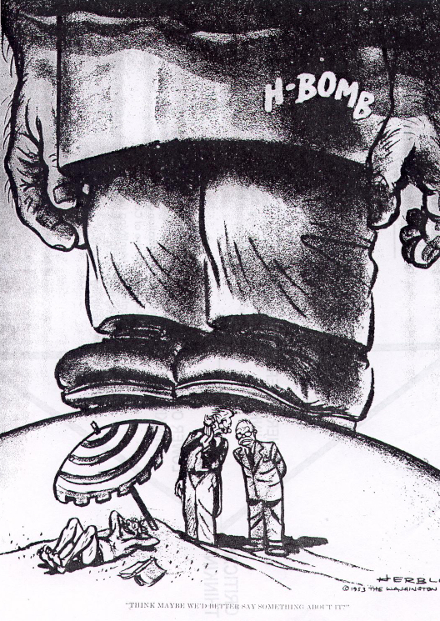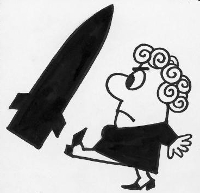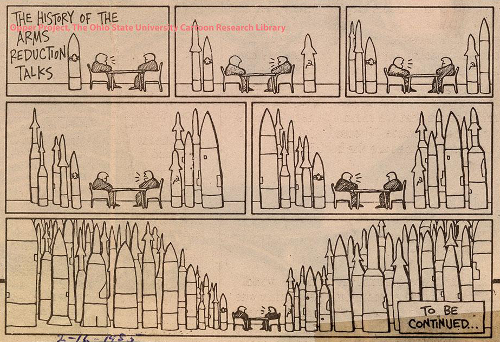That prospective reality never went away and its chances keep increasing.
If we do not abolish nuclear weapons they will surely abolish us.
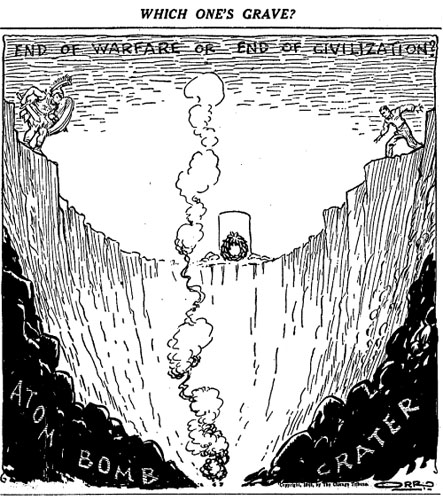
Chicago Tribune, 12 August 1945
|
In 1945, Albert Einstein said, “The release of atomic power
has changed everything except our way of thinking.” In
2015, seventy years later, we are still stockpiling nuclear
weapons in preparation for nuclear war. Our continued
willingness to allow huge nuclear arsenals to exist clearly shows
that we have not fundamentally grasped the most important truth
of the nuclear age: that a nuclear war is not likely to be
survived by the human species.
—Steven Starr:
“Nuclear War:
An Unrecognized
Mass Extinction Event Waiting To Happen” |
First Program in an Eight-Part Mini Series on the Symposium
produced by Maria Gilardin, Time of Useful Consciousness Radio
The articles that caused Dr. Caldicott to set up the conference:
-
“Transcending
Complacency on Superintelligent Machines,”
by Stephen Hawking, Max Tegmark, Stuart Russell, & Frank Wilczek,
The Huffington Post, 19 Apr 2014 -
“Transcendence
looks at the implications of artificial intelligence –
but are we taking AI seriously enough?,”
by Stephen Hawking, Max Tegmark, Stuart Russell, & Frank Wilczek,
The Independent, 1 May 2014 -
“But What Would the End
of Humanity Mean for Me?,”
by James Hamblin, The Atlantic, 9 May 2014
|
Here we are on this planet, and we humans have decided to build
this device. It’s called the Spectacular Thermonuclear
Unpredictable Population Incineration Device. I’m a
little bit inspired by Dr. Seuss here, I have to confess.
This is a long mouthful so let’s just abbreviate it:
S-T-U-P-I-D.
|
The US Nuclear Forces Modernization Program,
Rising Tensions with Russia, and
The Increasing Danger of a World Nuclear Catastrophe
Climatic Effects of Nuclear War,
Catastrophic Threats to the Global Food Supply
|
There are two types of targets: nuclear air bursts and
ground bursts. The cities would burn and firestorms
would build. Ground bursts also produce dust and in
one case the sunlight gets absorbed and in another
case it gets reflected. But that means very little
sunlight would reach the ground. And that would cause
rapid, large drops in surface temperature. This would
be devastation to agriculture and natural ecosystems.
|
A treaty banning nuclear weapons is a global humanitarian imperative of the highest order. It is achievable and increasingly urgent. The following provide means to implement a treaty banning nuclear weapons as well as increase consciousness of the necessity to do so.
- International Campaign to Abolish Nuclear Weapons
- Don’t Bank On The Bomb
- Study Wildfire Re: Outlawing Nuclear Weapons
- Sign Petition Supporting Nuclear Zero Lawsuits
- Sign Petition: Demand US President publicly acknowledges
and addresses the existential threat the US nuclear arsenal
poses to the continued existence of Life on Earth -
The World Peace Prayer Society
May Peace Prevail On Earth
to join efforts to achieve a global ban on nuclear weapons
• Humanitarian Pledge lists states pledged to fill the legal gap for the prohibition and
elimination of nuclear weapons—as of 1 Sep, 114 Nations have endorsed the Pledge
• Find out Who Supports A Global Ban On Nuclear Weapons
• Learn about the 425 Partner Organizations in 95 countries
• Tweet for a nuclear weapons ban
ICAN was launched in Vienna on April 30, 2007. This timeline conveys a sense of its momentum. The Campaign expects that the process to prohibit nuclear weapons will get started in 2015, and will need all the help possible to achieve the goal of enactment of an international treaty banning nuclear weapons. Please become a supporter and join the International Campaign to Abolish Nuclear Weapons.
- there is a humanitarian imperative to stigmatize nuclear weapons as fundamentally inhumane; banning them outright requires a comprehensive treaty-based approach rather than arms control;
- the time is right to build stronger links and common cause with local, national, and international humanitarian, peace, human rights, environmental, and disarmament NGOs, and to develop a network of civil society campaigners all over the world committed to push for nuclear abolition;
- non-nuclear-weapon states can and should take the lead to prepare for and negotiate a global treaty banning nuclear weapons, which will create an indisputable obligation for the nuclear-weapon states to eliminate their arsenals.
The financial institutions most heavily involved in financing nuclear weapons producers include Bank of America, BlackRock and JP Morgan Chase in the United States; BNP Paribas in France; Deutsche Bank in Germany; and Mitsubishi UFJ Financial in Japan.
- The Executive Summary provides a quick overview of global investments in nuclear weapons producing companies and of the conclusions drawn.
- The Don’t Bank on the Bomb 2014 Report provides all the details of the investments of 411 financial institutions in 28 identified producing companies. The report also provides profiles of the 28 nuclear weapons producing companies and the profiles of financial institutions in the Hall of Fame and Runners-Up categories. Research definitions, methodology and analysis of the data are found in the main report as well.
- Hans Kristensen, “Status of World Nuclear Forces,” Federation of the American Scientists, last updated: 29 Apr 2015
- Bruce Blair, “World Nuke Spending to Top $1 Trillion Per Decade,” Time, 4 June 2011; also see Bruce G. Blair and Matthew A. Brown, Global Zero Cost Study, June 2011.
some cold hard truths
Nuclear-weapon states will not engage in negotiations on a comprehensive nuclear disarmament treaty. Not now, not ever.
Negotiating detailed disarmament procedures and verification provisions for nuclear weapons is vastly complex - and pointless without the participation of the nuclear-weapon states.
The so-called step-by-step approach has got nowhere. This will not change.
The NPT legitimizes nuclear weapons. It holds the non-nuclear-weapon states in thrall, powerless and paralyzed by their good intentions, as eternal supplicants to the nuclear powers.
The civil society effort to abolish nuclear weapons is flailing. Without a clear, achievable short-term goal, it cannot unify, focus or exert effective pressure on governments.
All the cards are on the table. The catastrophic consequences of any use of nuclear weapons are understood. The motivations of the nuclear-weapon states are clear. Further research, commissions, studies, analysis, eminent windbags and general whining will add nothing.
It’s time to change the game.
The key: separate prohibition from disarmament.
Outlaw nuclear weapons now. Disarmament will follow later.
Two steps to a world free of nuclear weapons:
- Negotiate, conclude and bring into force a ban.
- Negotiate the disarmament and verification process.
Nuclear-weapon states need not be involved in step 1.
Nuclear weasel states (NATO members and other umbrella-dwellers)
need not be involved in step 1.
Step 1 could be achieved in as little as two years.
There are around 140 states which could start step 1 now.
What are they waiting for?
Step 1 requires only a simple treaty:
- that completely and permanently bans the acquisition, possession, transfer and use of nuclear weapons: no exceptions, no loopholes, no withdrawals.
- that non-nuclear-weapon states parties to the NPT may join freely.
- that nuclear-weapon states (NPT parties or not) may join after entry into force by negotiating an accession protocol stipulating time-bound disarmament steps and verification provisions (Step 2).
(Click here to read more about the treaty in a separate window)
Significant resource provided by the Lawyers Committee on Nuclear Policy - LCNP.org The Marshall Islands and the NPT, Robert Alvarez, Bulletin of the Atomic Scientists, 27 May 2015
Provides historical background on the lawsuit
-
“Self-Assured
Destruction: The climate impacts of Nuclear War,”
by Alan Robock and Owen Brian Toon, Bulletin of the Atomic Scientists, 2012 -
“Nuclear
winter revisited with a modern climate model and current
nuclear arsenals:
Still catastrophic consequences,”
Alan Robock, Luke Oman, and Georgiy L. Stenchikov, Journal of Geophysical Research, 2007 -
“Atmospheric
effects and societal consequences of regional scale nuclear
conflicts
and acts of individual nuclear terrorism,”
O.B. Toon, R.P. Turco, et al, Atmospheric Chemistry and Physics, 2007
Authoritative peer-reviewed scientific studies (see References, below) predict that the detonation of even a small fraction of US and Russian nuclear arsenals in cities or industrial areas will leave the Earth essentially uninhabitable. Yet these studies have been ignored by you and all leaders of the nuclear weapon states as well as the mainstream media. Consequently most people are unaware of these scientific predictions, and do not realize the continued modernization of nuclear arsenals means preparation for a war that will destroy the human race. It is imperative that this information be widely publicized and that you, and the leaders of the other nations possessing nuclear weapons, take all necessary actions to prevent a nuclear war that would end human existence.
|
From:
Chris Jordan photographic
arts: “Edge-walking the lines between beauty
and horror, abstraction and representation, the near and the far,
the visible and the invisible, Jordan’s images confront the
enormous power of humanity’s collective will.”
E Pluribus Unum depicts the names of one million organizations around the world that are devoted to peace, environmental stewardship, social justice, and the preservation of diverse and indigenous culture. The actual number of such organizations is unknown, but estimates range between one and two million, and growing. |
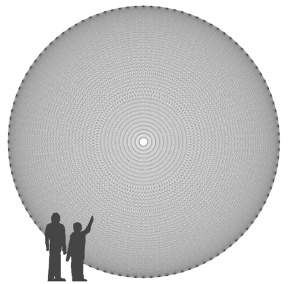
|
While there are a wealth of disturbing facts visualized by Jordan, still, as with all the eternal opposites, forever joined like two sides of a coin, there is also the “enormous power of humanity’s collective will” to understand and be informed by. This power is what we must ALL engage, direct, and focus, to close the book on the possibility of nuclear annihilation for the sake of the children, all we share Earth with, and all yet to be born and live out their lives here long, long, long after we are gone. |
| E Pluribus Unum, 2010 24x24 feet, laser etched onto aluminum panels | ||
May Peace Prevail On Earth
Thought forms create an energetic field strong enough to empower the course of planetary destiny.
Words carry vibrations strong enough to inspire, heal and transform the human heart as well as the Kingdom of plants, animals and all creation.
May Peace Prevail On Earth is an all inclusive message and prayer. It is a meeting place of the heart bringing together people of all faiths, backgrounds and culture to embrace the Oneness of our planetary family.
To spread the Universal Peace Message and Prayer, May Peace Prevail On Earth, far and wide to embrace the lands and people of this Earth
|
It is the
non-nuclear-weapon states on whom we must depend to drive a
process to ban nuclear weapons, to stigmatize them, to make
them socially and politically unacceptable, to make it harder
for nations to get away with possessing and upgrading them,
and to help the nuclear-weapon states overcome this awful,
debilitating addiction.
—Tim Wright:
“A New Movement to Ban Nuclear
Weapons”
|
-
The Power of Nuclear Weapons, Then and Now
-
The Humanitarian Impact of Nuclear Weapons
-
Eric Schlosser: The Most Dangerous Machines
-
The US Nuclear Weapons Labs:
Deception Is Baked Into Their DNA -
Nukemap: Personalizing the Bomb
-
Evacuation Zones for Nuclear Reactors
-
Radioactivity in Spent Nuclear Fuel Pools in the US
—Threat of Massive Releases During War Fighting -
70th Year Articles Worthy of Note
-
Notes from Talks by DTR
The single atomic bomb that destroyed the Japanese city of Hiroshima on August 6, 1945 had an explosive power of roughly 15,000 tons of TNT (also called 15 kiltons). This is a picture of Hiroshima before the atomic bomb was detonated:

|
It is shocking to see what the atomic bomb did to Hiroshima. More than 4 square miles of the city were utterly destroyed, transforming it into a barren wasteland.
|
Images presented on Hiroshima:
the first city destroyed by a nuclear weapon
from Nuclear Darkness, Global Climate Change & Nuclear Famine – The Deadly Consequences of Nuclear War
CLICK AN IMAGE TO VIEW HI RESOLUTION PANORAMA
|

Hiroshima
Peace Memorial Museum, Photo by Shigeo Hayashi - RA119-RA134
|

360 degree view span
Hiroshima
Peace Memorial Museum, Photo by H.J. Peterson - K-HJP001-K-HJP013
|

360 degree view span
Hiroshima
Peace Memorial Museum, Photo by Shigeo Hayashi A723-A742
|
Today, one of the standard single strategic nuclear warheads in the US and Russian arsenals contains an explosive power of about 800 kilotons (800,000 tons) of TNT. Such a thermonuclear warhead contains 64 times more destructive force than the Hiroshima bomb. The following is an excerpt from Steven Starr’s talk:
The firestorm produced by a strategic nuclear weapon is vastly larger than that produced by an atomic bomb. This graphic illustrates the most likely size of a fire zone, created by an 800 kiloton strategic nuclear warhead. This graphic shows it also being detonated above where we are now in New York.
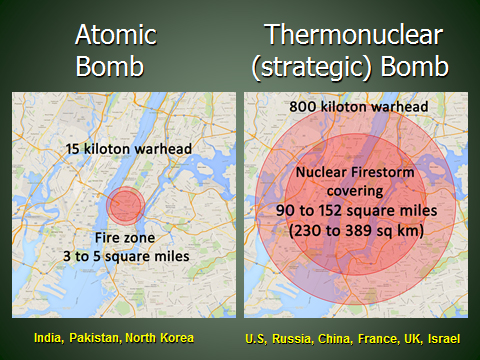
On an average day, the detonation of the warhead would instantly ignite fires over a total area of approximately 90 to 152 square miles. 20 to 30 minutes after the detonation, these fires would have joined together to form a single, immense firestorm.
Air temperatures in the fire zone would be above the boiling point of water. Hurricane force winds would blow towards the center of the firestorm, driving the flames horizontally, causing everything remotely flammable to burn. There would be no survivors in the fire zone.
Remember, 800 kilotons equals 800,000 tons of TNT. Russia has 1,000 strategic nuclear warheads that it can launch with less than 15 minutes warning, and 700 of these have an explosive power of 800 kilotons. In a war with the US, it would require about 30 minutes for these warheads to hit US cities.
Imagine a nuclear war in which hundreds or thousands of such firestorms were ignited in the course of less than one hour. There would be hundreds of cities, and hundreds of thousands of square miles, all burning at the same time....
The US and Russia together maintain a total of more than 800 launch-ready ballistic missiles, which can be fired with less than 15 minutes warning, and will strike their targets in 30 minutes or less. Once they are launched, they cannot be recalled from flight. These missiles are armed with a total of about 2400 strategic nuclear warheads, which have a combined explosive power of approximately 808 million tons of TNT.
That’s a lot of TNT to visualize. The explosive power of 808 million tons of TNT is easier to visualize if you have something to compare it to.

The small red dot on the left side of this figure represents 2.7 million tons of TNT, which is estimated to be the total explosive power of all the bombs exploded by all the armies of the world during the 5 years of World War 2.
The large red circle represents the 808 million tons of TNT explosive power of US and Russian launch-ready nuclear weapons. This amount is 300 times greater than the explosive power of all the bombs exploded during World War 2. It would require less than one hour for these launch-ready weapons to all detonate over their targets.
∧
Vienna Conference on the Humanitarian Impact of Nuclear Weapons
8-9 December 2014
Global Impacts of Limited Nuclear War on Agriculture, Food Supplies, and Human Nutrition,”
Ira Helfand, MD, International Physicians for the Prevention of Nuclear War (IPPNW),
Physicians for Social Responsibility, 2013
Banning Nuclear Weapons: The Humanitarian Facts (PDF)
IPPNW Campaign Kit, November 2014
∧
Eric Schlosser speaking on 8 December 2014 at the Vienna Conference on the Humanitarian Impact of Nuclear Weapons in Session II, “Risk Drivers for Deliberate or Inadvertent Nuclear Weapons Use.”
∧
Greg Mello and Robert Alvarez were two speakers at the Symposium who possess significant understanding of the United States Nuclear Weapons Labs. The following promotes understanding of how the Nuclear Weapons Labs system operates and how the business of nuclear weapons actually functions.
In his presentation at the Symposium, Greg Mello reviewed some of the history of the creation of nuclear weapons and the culture of the U.S. nuclear weapons complex. The following is an excerpt of his talk. [See Also: Interview with Greg Mello: “3 National Nuclear War Laboratories Have Run Amok, Block Disarmament, & Should Be Shut Down,” Los Alamos Study Group, 6 March 2015]
The people in charge of the Manhattan Project knew, 17 months before the Trinity test that Germany was on the road to defeat. Los Alamos was founded the same month as the Russian victory in Stalingrad. Project Alsos went through Europe and the information began to come back. By the time they interviewed Joliot-Curie it was all clear. But that was when the work truly speeded up.
Starting from March 1944 it was understood by General Groves as well as the leading scientists at Los Alamos that this was a project about post-war domination. There was a dinner at the Chadwick’s house in Los Alamos that Joseph Rotblat was at and wrote about subsequently where General Groves said this is about controlling Russia after the war. That was in March of 1944. All the information about how there wasn’t a German bomb program was all in hand by the end of ’44, and that’s when Joseph Rotblat quit.
The two lessons that you get from this and much more history is that deception is baked into the DNA [of the nuclear weapons labs] both for internal morale purposes as well as for funding, for CYA, for everything. And the second is that the bureaucracies once set in motion cannot absorb new information from the real world. So we have a changing national security situation today but the nuclear weapons complex and the military industrial complex cannot absorb this information. It will be decades, if ever, before they could ever—it will only absorb things if it’s profitable. And they have built now, a system, of such inordinate profitability that they can’t learn. They can’t manage, they can’t finish projects, and they can’t learn.
The salaries at the weapons laboratories are among the
most highly guarded secrets out there. I can give you a few
hints. There’s about a thousand people at each weapons
laboratory that make on the order of 350,000 a year. This
is much more than Cabinet officials or members of the Joint
Chiefs of Staff. These are not senior scientists. These are
mid-career people. The average compensation at the weapons
laboratories is on the order of 180,000. That includes
pension and health care and so forth. The Directors of the
laboratories make a million and a half or even more. The
upper-most management is also very highly compensated. No
one can make this kind of money in the real world. And so
they’re locked into a situation where they can’t change,
they can’t work on things that they would have to compete
with people at universities or anywhere else in society.
They’re locked in. And I think that a lot of the activists
don’t really get this ... They forget things like conflict
of interest, they don’t really know how much money
they’re making, and they don’t know how little
expertise of any broad sense is present in these laboratories....
(recording span: 12:02-15:48)
What we did not understand in the beginning but we do
understand now is that the Cold War was only over on
one side. That’s why I put in a little [bit] ... about
PNAC. There was an end-run around reform. And there have
been phases of break out from government control. One
person in government remarked to me that the laboratories’
basic business plan is to substitute themselves for the
government decision-making process, control all the
information that could make it possible for government
to reassert its authority, and to blackmail the government
if any attempt is made to change either of the first two
conditions. The blackmail is accomplished through the annual
stockpile certification letter and through a broader suite
of political activities in which they engage.... It goes
beyond lobbying to simply replacement of government. This
is so confusing that even Senator Feinstein did not know
that the Directors of the weapons laboratories are
contractors. She thought they were federal.
(recording span: 16:29-18:22)
-
More
bucks for the bang, 23 Feb 2015
“The cost of the nuclear weapons complex keeps going up, even as the size of the nuclear arsenal falls.” -
Rebranding
the nuclear weapons complex won't reform it, 18 Jan 2015
“The nuclear weapons production and laboratory system created during the Cold War is simply far too large for the current military situation and needs drastic consolidation that includes the closing of labs and other facilities.” -
The
nuclear weapons dismantlement problem, 1 Nov 2014
“In preparation for the Nuclear Non-Proliferation Treaty (NPT) review conference next year, the United States reports great progress in physically dismantling its nuclear weapons—a foundation for a key pillar of the treaty, which aims, ultimately, to reduce and eventually eliminate the arsenals of the world’s nuclear powers. The US Government Accountability Office (GAO), however, presents a very different picture.” -
Y-12:
Poster child for a dysfunctional nuclear weapons complex, 4 Aug 2014
“The Y-12 National Security Complex has not produced weapons for some 25 years, but its annual budgets have increased. by nearly 50 percent since 1997. The dysfunction must end, sometime.” -
The
WIPP problem, and what it means for defense nuclear
waste disposal, 23 Mar 2014
“As Energy Department contractors send robots to explore WIPP's caverns, the future of the world’s only operating high-hazard radioactive waste repository is uncertain.” -
A
primer: Military nuclear wastes in the United States, 24 Feb 2014
“The radioactive legacy of the US nuclear weapons program has spawned the most costly, complex, and risky environmental cleanup effort ever undertaken, with a long-term liability estimate ranging up to $1 trillion.”
∧
Teaching an Online Generation About The Effects of Nuclear Weapons
∧
Physicians for Social Responsibility
∧
In his symposium presentation, Steven Starr described how the rods in a nuclear spent fuel pool contain 5 to 7 times more radioactivity than is inside the nuclear reactor and that “even if spent fuel pools are not directly targeted in a nuclear war or during wartime, they would probably still be destroyed by the long-term loss of off-site electrical power, which is required to run their cooling systems ... [and subsequently] release huge amounts of radioactivity”. Although the following report does not specifically mention loss of on-site power as a result of nuclear or conventional war fighting, its information is nevertheless extremely relevant regarding the vulnerability of spent nuclear fuel pools being breached from any kind of warfare.
Spent Nuclear Fuel Pools in the US:
Reducing the Deadly Risks of Storage
by Robert Alvarez, Institute for Policy Studies, May 2011
Complete IPS Report (PDF, 36 pages)
IPS Fact Sheet (1 page)
Quick Facts About
Safer Storage of Spent Nuclear Fuel, Union of Concerned Scientists
∧
- Docs and Nukes — Still a Live Issue, by Ira Helfand, M.D., and Victor W. Sidel, M.D., New England Journal of Medicine, 14 Oct 2015
-
U.S.
Bows Out After Plowshares Conviction is Vacated:
Appeals Court Ill-Informed on Nuclear Overkill, by John LaForge, Counterpunch, 25 Aug 2015 -
Nuclear Power: Insurance and Health:
Nuclear
Insurance: America Goes Naked,
Earth Focus, KCET Los Angeles Community Television, 25 Aug 2015 (26:40) -
Bob
Dylan and America’s 70-Year Nuclear Nightmare
by Rev. John Dear, Counterpunch, 7 August 2015 -
Hiroshima
and Nagasaki: Gratuitous Mass Murder
by Stephen Lendman, Counterpunch, 7 August 2015 -
Demystifying
Nuclear Power: 70-Years After Nuclear Carnage,
by Caroline Phillips, Fairwinds Energy Education, 7 Aug 2015 - 70 Years on from Nuclear Devastation, by Emily Watson, Politics Personified, 7 August 2015
-
The
War Was Won Before Hiroshima—And the Generals Who Dropped the Bomb Knew It
Seventy years after the bombing, will Americans face the brutal truth?
by Gar Alperovitz, The Nation, 6 August 2015 -
by Miriam German, director of
Radcast.org,
in Counterpunch:
- Why Fukushima Ended All Debate About Nuclear Power, 11 Mar 2015
- Meet the Real Nuclear Terrorist Organization, 23 Mar 2015
- The Real Nuclear Threats, 10 Apr Mar 2015
- Nuclear Number Games, 29 Apr 2015
- Follow the Radiation, 7 Aug 2015
-
The
harrowing story of the Nagasaki bombing mission,
by Ellen Bradbury & Sandra Blakeslee, Bulletin of the Atomic Scientists, 4 Aug 2015 -
Call
for Sanity on Sixtieth Anniversary of the Russell-Einstein Manifesto,
by Emanuel Pastreich, Foreign Policy in Focus, 9 Jul 2015 - Nuclear Weapons Proliferation: Made in the USA, by John LaForge Counterpunch, 27 May 2015
-
End Launch-on-Warning — Take Missiles Off Hair-Trigger Alert:
U.S. and Russian Generals Call for Reducing the Risk of Inadvertent Nuclear War,
by David Wright, Union of Concerned Scientists, 20 April 2015
∧
A New Movement to Ban Nuclear Weapons
-
Notes for Talk to Students at Edison H.S.,
Fresno, CA, 1 Sep 2015
These notes were used to speak to 5 classes of students my brother teaches -
Notes for Talk at Piedmont Gardens, Oakland, CA, 2 Sep 2015
These notes were used to speak by invitation of
the Peace and Justice Committee of Piedmont Gardens to its residents.
50 copies of <ratical.org/neo> and <wildfire-v.org/NPT2015/Ban_outline2.pdf> were printed of these combined 14 pages-worth and all the handouts were taken away by the residents. -
An Expanding Light to
Dispel the Darkness:
A New Movement to Ban Nuclear Weapons, Hiroshima Day, 2015
Elements of this essay were used to compose portions of the Piedmont Gardens presentation.
|
[Starting in the late 1970s] I organized with others, Physicians for Social Responsibility and we held conferences throughout America describing the medical consequences of nuclear war. The first such symposium was held at Harvard and the reporters there were absolutely perplexed. They said, What are doctors talking about nuclear war for? This is a political issue. And we said, No, it’s not. It’s a medical issue because nuclear war will create the final epidemic of the human race. Then the Bishop, or Archbishop of Boston—Cardinal whoever—would wake up the next morning and there would be a map of Boston with the concentric circles of vaporization, and third degree burns, and fires, etc., and he’d say, I don’t think Jesus would approve of this. It happened all over the country so finally the Catholic Bishops got together and wrote a Pastoral Letter against nuclear war. Then the Methodist Bishops got together and they did a similar thing and their Pastoral Letter was even better than the Catholic Bishops. Eventually we had a million people in Central Park in 1982 in June, the biggest rally ever in the history of America. Black lesbians from Harlem, Southern Baptists, Mormons, everyone. It was just amazing. We had 80 percent of people supporting the notion that nuclear weapons must be eradicated, really. Gorbachev then had the support of the world with Reagan. They met in Reykjavík, these two men, and over a weekend they almost agreed to abolish nuclear weapons. So therefore there is a precedent to abolish nuclear weapons and it’s time that happened. The country that’s holding up the abolition of nuclear weapons is America. Without America moving, Russia won’t move. If America moves, unilaterally, Russia will too. We know that. Because they can’t afford these weapons and they’re very aware of what happens in war because they lost 30 million people on the Russian front in the Second World War and that’s deeply embedded in their souls. I can remember as a little girl standing in the kitchen. My mother said, Thank God, he’s turned on Russia. He’ll never beat Russia. But they suffered terribly. And they’ll never forget it.
—Helen Caldicott:
“Opening
Remarks”
|
This library is dedicated to the children, the Earth, and all Life exploring itself ongoing into what can only be called eternity. I am grateful to Dr. Helen Caldicott for her desparate passion to call us all to examine with intelligence and clarity the etiology of killing and the etiology of possible nuclear extinction so that we can heal this disease for the benefit of today and tomorrow. (She explained that physicians need to look at etiology of disease and that etiology means the cause of a disease.)
Steven Starr contributed the wording for the Petition to the President of the United States. It was his presentation, “Nuclear War: An Unrecognized Mass Extinction Event Waiting To Happen,” that generated the inspiration to make the petition. Mr. Starr, Alan Robock, Theodore Postol, Bruce Gagnon, and Tim Wright generously contributed copies of the text they read from and or slides where they were used. Michael Mills created the animations of Black Carbon Mass Mixing Ratio in greyscale at 10 frames and 5 frames per second. Maria Gilardin contributed the continuity of her First of Eight programs on this symposium. Richard Lennane gave helpful insights on the Petition to address the threat to all Life posed by the nuclear weapon states. Rebecca Lord helped with researching the petition process and its strategy. I especially wish to thank my wife, Nina. Through her counsel and advice she helps me see a wider perspective engendering more constructive communication. She is an advocate for and champion of the children in our community and their families and her devotion and dedication to serving our community is an inspiration to all who know her.
Many warnings have been uttered by eminent men of science and by authorities in military strategy.... We have found that the men who know most are the most gloomy.... People scarcely realize in imagination that the danger is to themselves and their children and their grandchildren, and not only to a dimly apprehended humanity. They can scarcely bring themselves to grasp that they, individually, and those whom they love are in imminent danger of perishing agonizingly.... We appeal as human beings to human beings: Remember your humanity, and forget the rest.
